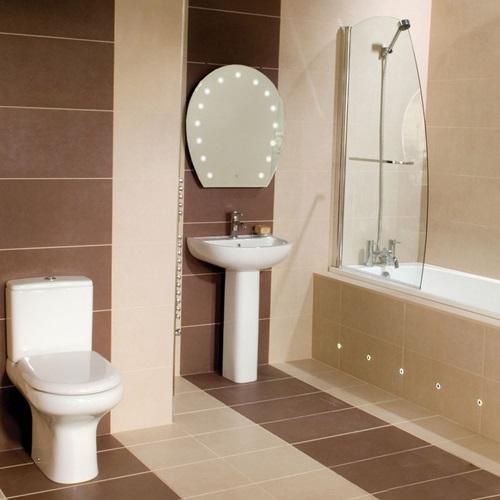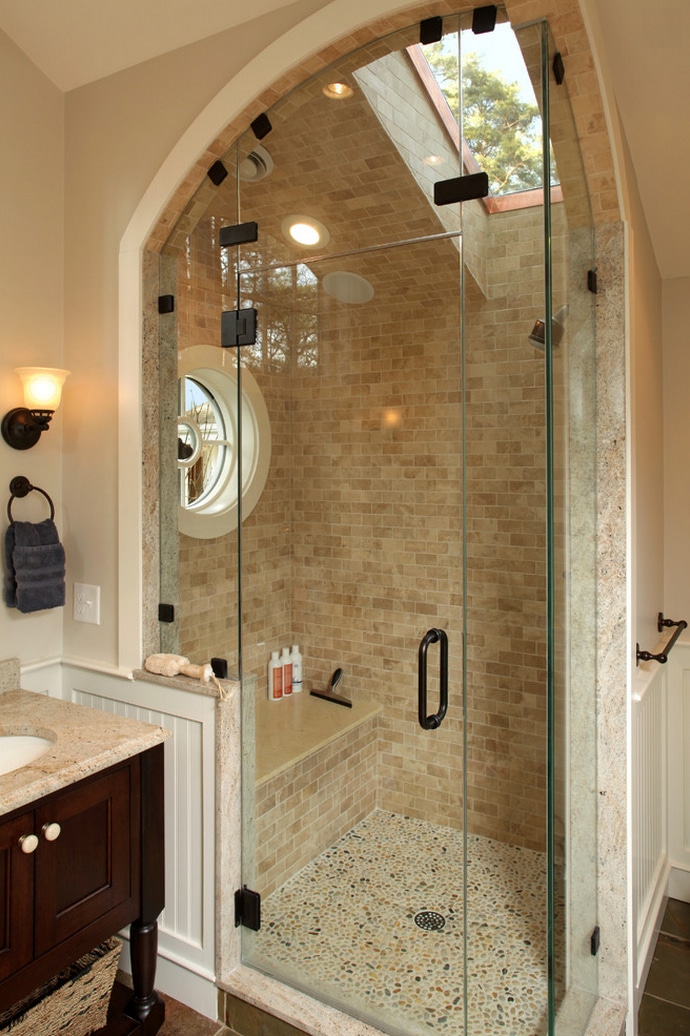Half tile wall bathroom involves selecting the right tiles to achieve the desired aesthetic, functionality, and durability. With a wide range of tile options available in the market, making the perfect choice can be overwhelming. In this comprehensive guide, we’ll explore various factors to consider when selecting tiles for a half-tile wall bathroom, including materials, colors, patterns, sizes, finishes, and maintenance requirements.

1. Materials:
Tiles come in a variety of materials, each with its own unique characteristics, pros, and cons. Common materials used for bathroom tiles include ceramic, porcelain, glass, natural stone (such as marble, granite, travertine, and slate), and engineered stone (such as quartz). Consider factors like durability, water resistance, ease of maintenance, and budget when selecting the material for your half-tile wall bathroom.
2. Colors:
The color scheme of the tiles plays a significant role in setting the mood and ambiance of the bathroom. Lighter colors can make the space feel more spacious and airy, while darker colors can add drama and sophistication. Consider the existing color palette of your bathroom, as well as your personal preferences and the desired atmosphere, when choosing tile colors. Neutral tones like white, beige, gray, and taupe are versatile options that can complement various design styles and decor themes.
3. Patterns:
Incorporating patterns into your half-tile wall bathroom can add visual interest and personality to the space. Popular tile patterns include subway, herringbone, chevron, basket weave, hexagon, and Moroccan-inspired designs. Choose a pattern that complements the overall style of your bathroom and enhances its aesthetic appeal. Mixing and matching different tile patterns can create a dynamic and visually stimulating effect.
4. Sizes:
Tiles come in a variety of sizes, ranging from small mosaic tiles to large-format tiles. The size of the tiles can impact the perceived scale of the bathroom and influence its visual aesthetics. Larger tiles can make a small bathroom appear larger and more spacious, while smaller tiles can add texture and detail to the walls. Consider the size of your bathroom, the layout of the walls, and the desired design outcome when selecting tile sizes.

5. Finishes:
Tiles are available in a range of finishes, each offering different levels of shine, texture, and slip resistance. Common tile finishes include glossy, matte, satin, textured, and polished. Glossy finishes can reflect light and create a bright, sleek look, while matte finishes offer a more subdued and understated appearance. Consider the practicality and maintenance requirements of each finish, especially in wet areas like showers and tub surrounds.
6. Maintenance Requirements:
When selecting tiles for a half-tile wall bathroom, consider the maintenance requirements of each tile material and finish. Some tiles may require regular sealing to protect against moisture and stains, while others may be more resistant to water and easier to clean. Choose tiles that are suitable for high-moisture environments and require minimal maintenance to keep your bathroom looking clean and pristine.
7. Budget:
Set a budget for your tile selection process to help narrow down your options and make informed decisions. Keep in mind that the cost of tiles can vary depending on factors like material, size, pattern, and brand. Consider the long-term investment value of higher-quality tiles that offer durability, longevity, and aesthetic appeal. Look for sales, discounts, and promotions to stretch your budget further and find the best value for your money.
8. Compatibility with Fixtures and Accessories:
Ensure that the tiles you choose for your half-tile wall bathroom are compatible with the existing fixtures, fittings, and accessories in the space. Consider factors like the color, style, and finish of the faucets, showerheads, towel bars, and other wall bathroom hardware when selecting tiles. Aim for a cohesive and harmonious design scheme that ties together all elements of the bathroom seamlessly.
9. Eco-Friendly Options:
For environmentally conscious homeowners, there are eco-friendly tile options available that are made from sustainable materials and produced using environmentally friendly manufacturing processes. Look for tiles that are certified by reputable organizations like the Forest Stewardship Council (FSC) or the Tile Council of North America (TCNA) for their sustainability credentials. Eco-friendly tiles can help reduce your carbon footprint and contribute to a healthier planet.

10. Seek Professional Advice:
If you’re unsure about which tiles to choose for your half-tile wall bathroom, consider seeking advice from a professional interior designer, architect, or tile specialist. They can offer valuable insights, recommendations, and expertise to help you navigate the selection process and make informed decisions based on your specific needs, preferences, and budget.
Advantages of bathroom tiles
Bathroom tiles offer a plethora of advantages, contributing to both the aesthetic appeal and functionality of the space.
1. Durability:
Bathroom tiles are known for their durability, making them an excellent choice for high-traffic areas prone to moisture and wear. They can withstand frequent use without showing signs of wear and tear, making them a long-lasting flooring and wall covering option.
2. Water Resistance:
One of the primary advantages of bathroom tiles is their water resistance. Whether it’s the splashes from the shower, steam from hot baths, or spills from sinks, bathroom tiles can effectively repel water, preventing damage to underlying surfaces and inhibiting the growth of mold and mildew.
3. Easy to Clean:
Bathroom tiles are relatively easy to clean, requiring minimal maintenance to keep them looking fresh and pristine. Most tiles can be wiped down with a damp cloth or mild cleaning solution to remove dirt, grime, and soap scum, making them an ideal choice for busy households.

4. Hygienic:
The non-porous surface of bathroom tiles makes them inherently hygienic, as they are resistant to bacteria, germs, and allergens. Unlike materials like carpet or wood, which can harbor microbes and allergens, tiles provide a clean and sanitary environment, promoting better indoor air quality and overall health.
5. Versatility:
Bathroom tiles come in a wide range of colors, patterns, sizes, and finishes, offering endless design possibilities to suit any style or preference. Whether you prefer a sleek and contemporary look with glossy white subway tiles or a rustic charm with textured stone tiles, there’s a tile option to complement any aesthetic.
6. Heat Resistance:
Bathroom tiles are heat-resistant, making them an ideal choice for areas near showers, tubs, and heated flooring systems. They can withstand exposure to hot water and radiant heat without warping, discoloration, or degradation, ensuring their longevity and structural integrity.
In conclusion
Selecting tiles for a half-tile wall bathroom involves careful consideration of various factors, including materials, colors, patterns, sizes, finishes, maintenance requirements, budget, compatibility with fixtures, and eco-friendliness. By taking these factors into account and exploring different options, you can create a beautiful, functional, and personalized bathroom space that reflects your style and meets your needs for years to come.

